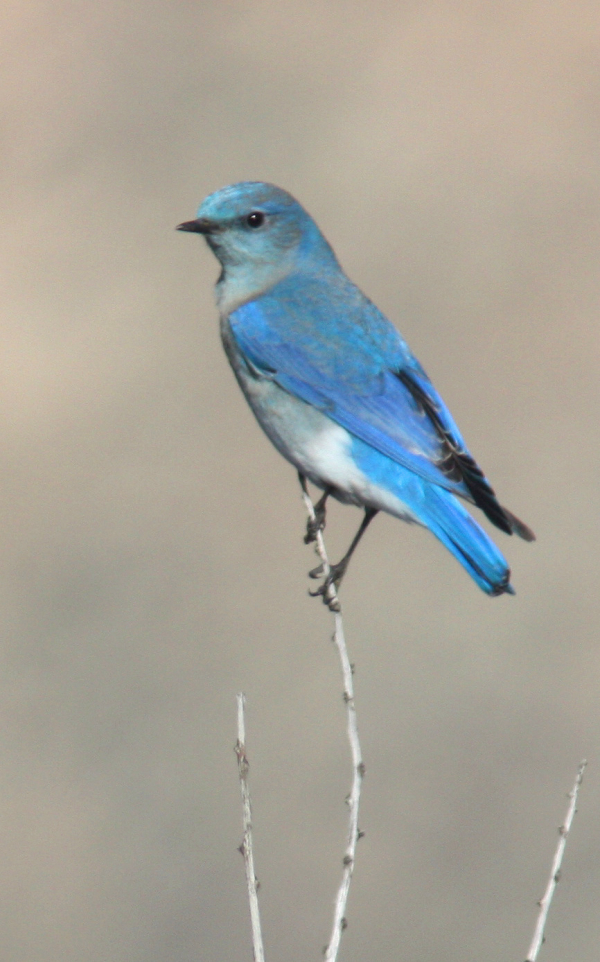
All three species of bluebirds, including Western Bluebirds as illustrated above, have benefitted greatly from the work and dedication of birders, spearheaded by the information provided and the outreach of the North American Bluebird Society.

Mountain Bluebirds may be the most unique species, and one that many birders travel to montane habitats to observe.
|
Bluebirds may be the most popular cavity nesting birds in North America, including all three species – Eastern, Mountain, and Western Bluebirds – all colorful, musical, and sure to attract the attention of any birders, actually any North Americans. When it became evident there was a shortage of suitable natural cavities and woodpecker-excavated cavities, an army of dedicated “bluebirders” rose to help en force to provide the best possible artificial cavities in the form of nest boxes – one by one, and eventually trail by trail.
A great boost for bluebird species and populations was the establishment of the North American Bluebird Society (NABS) in 1978 by Dr. Lawrence Zeleny and a dedicated group of bluebird enthusiasts who have expanded into today’s participating membership. The NABS website provides a wealth of information for birders interested in installing a new nest box, to enthusiasts who wish to establish and monitor their own bluebird trail. (Keep in mind that most of the information provided about bluebird nest boxes is true for a variety of other small cavity nesting birds.)
Beginners can start with the following link that provides everything you need to learn about getting started, to learn more about bluebirds and the nest boxes they need to bolster local populations, and even expand their continental ranges. To get started, see http://www.nabluebirdsociety.org/PDF/NABSFactsheetGettingStarted.pdf
Monitoring Nest Boxes
The Society points out the importance of monitoring each nest box once per week, as well as keeping records. In their valuable publication about monitoring nest boxes, there is a series of photographic illustrations that show the development of bluebird nestlings day by day. It’s an exceptional collection of photo illustrations to inform interested birders and especially to aid bluebird landlords in aging nestlings from hatching to fledging (20 days).
Just as impressive and helpful is a photographic list of a variety of common cavity nesting birds that might utilize a “bluebird” nest box, including Tree Swallows and Violet-green Swallows, House Wrens, chickadee species, and titmouse species. There are even insightful photo illustrations of what the different species’ nests look like, plus color photos of the eggs of each species showing comparative sizes and colors. All this information is most valuable for people monitoring one nest box, a dozen nest boxes, or a hundred. Check out this illustrated NABS publication at http://www.nabluebirdsociety.org/PDF/NABSFactsheetMonitoring.pdf
Predator-proofing
Anyone installing a nest box, or group of nest boxes, must appreciate the responsibility of this endeavor, the need to monitor nest boxes, and they must make the commitment to protect each nest box from potential predators. If properly predator-proofed, a nest box can be a safer nesting site than a natural cavity. That’s a great boon to any nesting pair of bluebirds or other cavity nesting birds – and, after all, no one wants to see their nest box turn into a predator feeding station. The effects of would-be predators can be controlled – even eliminated, as described in this illustrated NABS publication: http://www.nabluebirdsociety.org/PDF/NABSFactsheetPredatorControl.pdf
The North American Bluebird Society (NABS) provides a wealth of additional information in publications listed at http://www.nabluebirdsociety.org/nabs-fact-sheets/ and you can learn how to become a member of the NABS on their website too.
Whether you attract Mountain Bluebirds, Eastern Bluebirds, or Western Bluebirds, it’s time to gear up for the coming nesting season, and if you’re interested in getting started, the NABS is the place to get initiated. Enjoy the season with bluebirds and cavity nesting birds of all kinds!